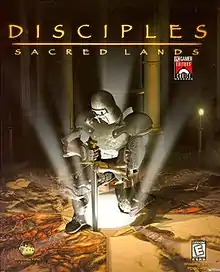| Disciples: Sacred Lands | |
|---|---|
 | |
| Developer(s) | Strategy First |
| Publisher(s) | GT Interactive |
| Director(s) | Stéphane Rainville |
| Producer(s) | Prokopios Sotos |
| Designer(s) | Danny Bélanger |
| Programmer(s) | Dominic Mathieu |
| Artist(s) | Benoit Carrière |
| Composer(s) | Sébastien Thifault |
| Platform(s) | Microsoft Windows |
| Release | |
| Genre(s) | Turn-based strategy |
| Mode(s) | Single-player, multiplayer |
Disciples: Sacred Lands is a turn-based PC strategy game published by Strategy First in 1999. Set in a fantasy world known as the Sacred Lands, it depicts a battle for dominance between four races of the world of Nevendaar: The Empire (humans), the Mountain Clans (dwarves) the Legions of the Damned (demons), and the Undead Hordes (undead). In 2001, an expanded version of the game was released titled Disciples: Sacred Lands - Gold Edition. It added 25 new scenarios.
Gameplay
Gameplay consists of three major components: The Capital City, where the player recruits units, constructs buildings, and researches spells, The Adventure Map, where the player leads Heroes and their parties to explore the land, and the Battle Screen, where battles are fought whenever hostile parties meet on the adventure map.
The game has many similarities with the Heroes of Might And Magic series, such as having a leader, creature slots, city improvements, an adventure map with resources and hostile creatures, along with the turn-based gameplay.
Key characteristics of Disciples:
- Small squads with Experience: As opposed to the rival Heroes of Might and Magic franchise, armies in Disciples are not composed of 'stacks' but of small groups of individual units which can only be recruited at the lowest level and upgrade as they gain experience.
- Fixed battle positions: The battles are not fought on a 'map' where units can move about. They have specific stations, but their representation on a plane is purely symbolic, and they can attack any enemy targets (although there are restrictions about ranks and melee attacks), similar to the battle system in tactical RPGs.
- Distinctive Art style: The graphics and art in Disciples, both computer and hand-drawn, have always had a very distinctive style to them, with very dark browns and sombre colours, baroque details, and skewed proportions. The overall atmosphere of the game is greatly enhanced by the characteristic graphics.
Reception
Critical reviews
| Aggregator | Score |
|---|---|
| GameRankings | 82%[2] |
| Publication | Score |
|---|---|
| CNET Gamecenter | 7/10[3] |
| Computer Games Strategy Plus | |
| Computer Gaming World | |
| EP Daily | 7/10[6] |
| GamePro | |
| GameSpot | 8.3/10[8] |
| GameZone | 5.2/10[9] |
| IGN | 8.5/10[10] |
| Jeuxvideo.com | 13/20[11] |
| PC Gamer (US) | 89%[12] |
The game received "favorable" reviews according to the review aggregation website GameRankings.[2]
Sales
According to Strategy First, the game "didn't get great distribution" in its initial run.[13]
Awards
The game won the award for "Best Game No One Played" at GameSpot's Best & Worst of 1999 Awards,[14] and was a runner-up for the "Best Graphics, Artistic Design" award, which went to Rayman 2: The Great Escape.[15]
Sequels
Three sequels have been released: Disciples II: Dark Prophecy in 2002, Disciples III: Renaissance in 2009, and Disciples: Liberation in 2021.
References
- ↑ Fudge, James (September 30, 1999). "Disciples: Sacred Lands Hits Retail". Computer Games Strategy Plus. Strategy Plus, Inc. Archived from the original on May 24, 2003. Retrieved July 8, 2022.
- 1 2 "Disciples: Sacred Lands for PC". GameRankings. CBS Interactive. Archived from the original on May 30, 2019. Retrieved July 8, 2022.
- ↑ Conley, Eric (October 5, 1999). "Disciples: Sacred Lands". Gamecenter. CNET. Archived from the original on August 16, 2000. Retrieved July 8, 2022.
- ↑ Rickmann, Merrie (September 15, 1999). "Disciples: Sacred Lands". Computer Games Strategy Plus. Strategy Plus, Inc. Archived from the original on May 12, 2003. Retrieved July 8, 2022.
- ↑ Green, Jeff (December 1999). "Disciples: Sacred Lands" (PDF). Computer Gaming World. No. 185. Ziff Davis. p. 158. Retrieved July 22, 2017.
- ↑ Grant, Jules (October 25, 1999). "Disciples: Sacred Lands". The Electric Playground. Greedy Productions Inc. Archived from the original on April 30, 2003. Retrieved July 8, 2022.
- ↑ Brenesal, Barry (October 7, 1999). "Disciples: Sacred Lands Review for PC on GamePro.com". GamePro. IDG Entertainment. Archived from the original on June 24, 2004. Retrieved July 22, 2017.
- ↑ Park, Andrew Seyoon (September 28, 1999). "Disciples: Sacred Lands Review". GameSpot. Red Ventures. Archived from the original on December 29, 2004. Retrieved July 8, 2022.
- ↑ Lupos (September 19, 1999). "Disciples: Sacred Lands Review". GameZone. Archived from the original on January 14, 2004. Retrieved July 22, 2017.
- ↑ Ward, Trent C. (October 18, 1999). "Disciples: Sacred Lands". IGN. Ziff Davis. Retrieved July 22, 2017.
- ↑ pilou (January 22, 2002). "Test: Disciples : Sacred Lands". Jeuxvideo.com (in French). Webedia. Archived from the original on September 18, 2020. Retrieved July 8, 2022.
- ↑ Trotter, William R. (December 1999). "Disciples [Sacred Lands]". PC Gamer. Vol. 6, no. 12. Imagine Media. Archived from the original on March 15, 2006. Retrieved July 22, 2017.
- ↑ Asher, Mark (June 2001). "GameSpin #14 -- Strategy First (Page 2)". GameSpy. IGN Entertainment. Archived from the original on February 15, 2005. Retrieved July 8, 2022.
- ↑ GameSpot staff (2000). "The Best & Worst of 1999 (Best Game No One Played)". GameSpot. Ziff Davis. Archived from the original on August 23, 2000. Retrieved July 8, 2022.
- ↑ GameSpot staff (2000). "The Best & Worst of 1999 (Best Graphics, Artistic Design)". GameSpot. Ziff Davis. Archived from the original on August 23, 2000. Retrieved July 8, 2022.
External links
- Official website (archived)
- Disciples: Sacred Lands at MobyGames